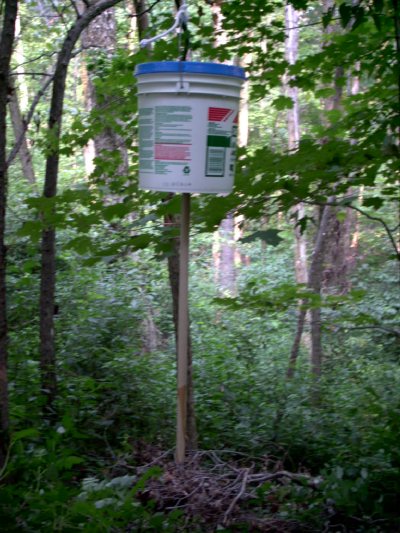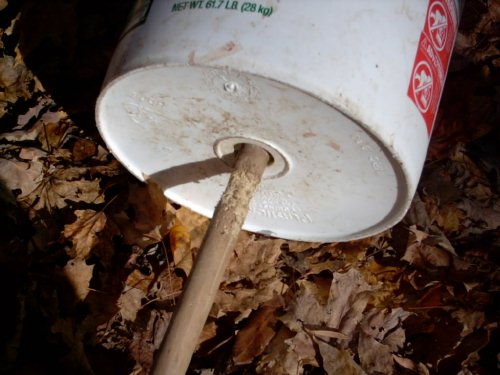Bucket Deer Feeder
We decided to try and make our own bucket deer feeder since there seems to be a lot of interest in feeding deer as well as interest in building your own homemade bucket deer feeder without spending a lot of money. We've done a little experimenting over the years trying a couple of different things.We have used PVC pipe to build gravity deer feeders and we now use automatic spin cast deer feeders that have gone through a few generations of modifications. The interest in cheaply building your own bucket deer feeder led us to try something different just to see how well they work.
The large consumption of corn and the mess when it rained forced us away from the PVC deer feeders years ago. A while back I saw where someone made a bucket deer feeder using a 5-gallon plastic bucket with a wooden dowel(broom handle) protruding from a hole in the bottom of the bucket. When deer move the dowel corn is supposed to fall form the hole. This can be hung from a tree and may deter stealing by varmints. The deer will have to learn to hit the dowel to receive corn and the bucket feeder must be hung high enough that only deer can hit the stick.
We're testing the feeder to see how it works. I have suspicions that the varmints will figure it out. They have chewed holes through our plastic feeders in the past and I suspect they will eventually do that to our bucket feeder.
To make our bucket feeder we used the following items: 5-gallon plastic bucket with snap on lid (empty drywall bucket) 1-dowel rod, about 36-inches long (left-over from another project) 5/16-inch braided nylon rope 3-inch course thread screw
Tools: Drill with a 1-inch spade bit Dremel tool and sanding wheel
To make the bucket feeder we drilled a 1-inch hole in the bottom of the bucket and then sanded it out to 1 3/8-inch diameter. We did this a little bit at a time and kept testing it to see of corn fell out when we moved the dowel rod. Remember, once the whole is too big there is no turning back.
We put the 3-inch screw through the dowel rod to suspend it in the hole in the bucket and then we simply tied the rope to the handle and threw it over a tree limb and pulled the feeder up.
To try to get the deer to come to the feeder we sprinkled some corn around on the ground and put some pancake syrup on the dowel rod to try to get the deer to lick it. When they lick the dowel hopefully corn will fall out and they will learn how to get the corn out by licking or moving the dowel rod.
So far our bucket deer feeder hasn't been succesful. The hole isn't big enough so we need to dremel it out some more.
The scouting camera that we had on the feeder showed that deer didn't have any interest in the bucket deer feeder the first couple of weeks that it was out.
The partially fallen tree that we had the bucket feeder hanging from has fallen more and more over the past few weeks so we had to move it. We just threw the rope over a maple tree branch nearby. If we move the rod corn still falls out. Maybe we'll get a chance to try to make the hole a little bigger. The feeder still has the original corn in it.
Over the next couple of weeks we never enlarged the hole but the raccoons had found the feeder. They chewed on the dowel and corn now freely fell from the bucket when the dowel was moved.
A week before buck season we decided to go ahead and attach our old spinner feeder to the bucket. My Dad had a suspicion that there were some bucks at the far end of our property that we weren't seeing so we put the feeder out there to see what would come to it.
Overall our homemade bucket feeder was a marginal success. With the way the raccoons were chewing on the dowel rod it may not have lasted much longer.
This is how our bucket deer feeder looks. A little camo paint would be a nice touch but the whitetails won't care.

This is what our bucket deer feeder looked like when we took it down to put on the spinner feeder.

Return from the Bucket Deer Feeder Page to the Deer Feeder Page.
You can take a look at Ryan hanging the bucket feeder with the spinner feeder here.
